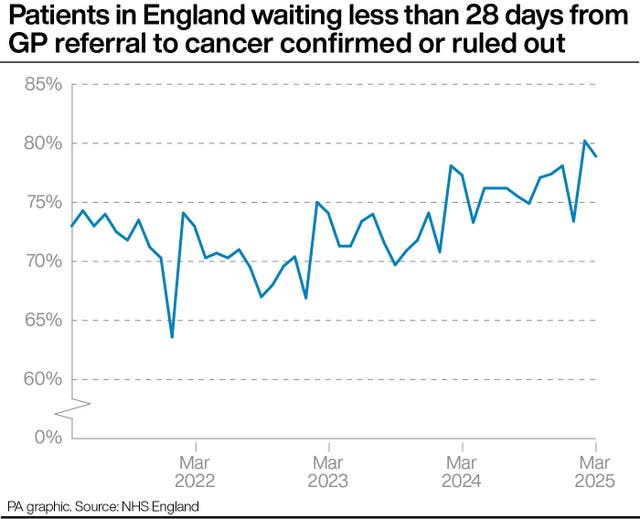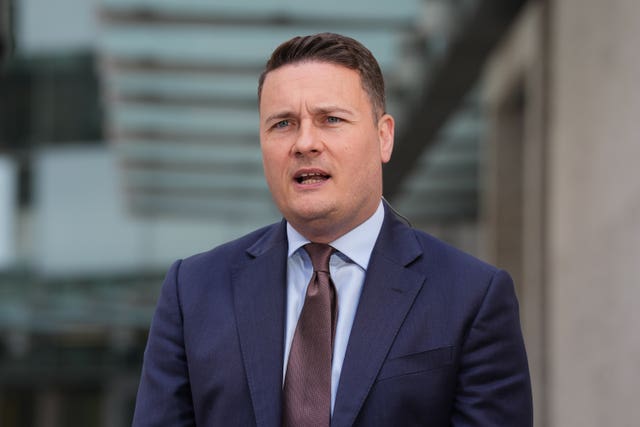NHS waiting list for hospital treatment rises for first time in seven months
The data will be a blow to Labour, which is introducing ‘carrot and stick reforms’ for NHS leaders.

The NHS waiting list for hospital treatment in England has risen for the first time in seven months.
New figures show an estimated 7.42 million planned treatments were waiting to be carried out at the end of March, relating to 6.25 million patients – up slightly from 7.40 million treatments and 6.24 million patients at the end of February.
The data will be a blow to Labour, which is introducing “carrot and stick reforms” for NHS leaders in a bid to speed up progress across the health service.

Health Secretary Wes Streeting has set out plans to reward leaders who slash waiting times and improve services for patients, while penalising failing managers.
He said bonuses and pay rises will be a “reward and not a right”.
The new figures from NHS England show some progress in cutting very long waits.
Some 1,164 patients in England had been waiting more than 18 months to start routine treatment at the end of March, down from 1,691 in February.
A year earlier, in March 2024, the number stood at 4,769.
There were also 7,381 patients who had been waiting more than 65 weeks to start treatment, down from 13,223 the previous month. This figure stood at 48,967 in March 2024.
NHS England said the health service delivered over 100,000 more treatments in March compared to the same month last year.
March was the busiest March ever for the number of tests and checks carried out for patients, it added.

Mr Streeting said: “Since day one, we have been clear it will take time to reverse the disastrous waiting list we inherited.
“But since July, real progress has been made – including over winter. We have overseen a massive increase in appointments available to meet rising demand, reduced long waits and helped people get diagnosed quicker.
“Thanks to the hard work of NHS staff, we have now delivered more than 3.6 million extra appointments, helping hundreds of thousands of people get off the waiting list and get on with their lives.
“Our plan for change will continue to put patients first as we work to end the misery felt by millions up and down the country who have been denied the care they need for too long.”

The size of the waiting list can be affected by seasonal factors – for instance, in the years immediately before the Covid-19 pandemic there tended to be an increase in the early months of the year, with more people coming forward for treatment after the winter.
In recent years, seasonal trends have not been so clear, thanks to the impact on waiting lists of the pandemic and industrial action by NHS staff.
Professor Sir Stephen Powis, NHS England’s national medical director, said: “The scale of demand that our frontline NHS teams are managing is enormous – today’s figures show that each month, they are having to not only deal with an historic backlog, but they are also working to keep up with the hundreds of thousands of new patients that need our care.
“In March, we saw a particularly sharp rise in referrals – yet staff still managed to deliver more for patients with 100,000 more treatments delivered and thousands more getting a timely diagnosis for cancer.”

Professor Frank Smith, vice president of the Royal College of Surgeons of England, said staff were working tirelessly.
But he added: “We can’t get away from the fact that the pace of progress remains sluggish. This calls into question whether Government targets will be met.
“Our members frequently tell us they could be doing more surgeries if they had enough operating theatres, or if existing facilities weren’t out of commission due to disrepair.
“Without better access to operating theatres for surgical teams, the NHS will fail to make the productivity gains needed to meet targets and patients will continue to endure unacceptably long waits.
“If this Government is serious about delivering on its waiting time pledges, it must be realistic and find further capital funding to repair crumbling NHS estates and expand capacity.”

Sarah Scobie, deputy director of research at the Nuffield Trust, said: “Focusing on big waiting lists for treatment makes sense for the Government – around half of the public state that better hospital waiting times is one of the most important priorities for the NHS – but this cannot be at the expense of emergency care.
“Still, over 25% of people were waiting more than four hours in A&E in April and nearly 45,000 people waited over 12 hours on a trolley because hospital beds were unavailable.
“The number of people facing extremely long waits for a hospital appointment has reduced, but progress in bringing down the overall waiting list is stalling.
“The Government is hoping that initiatives like expanding use of advice and guidance in general practice will help, so a big question as ministers prepare the 10-year health plan is whether things will get back on track with driving down the backlog.”





